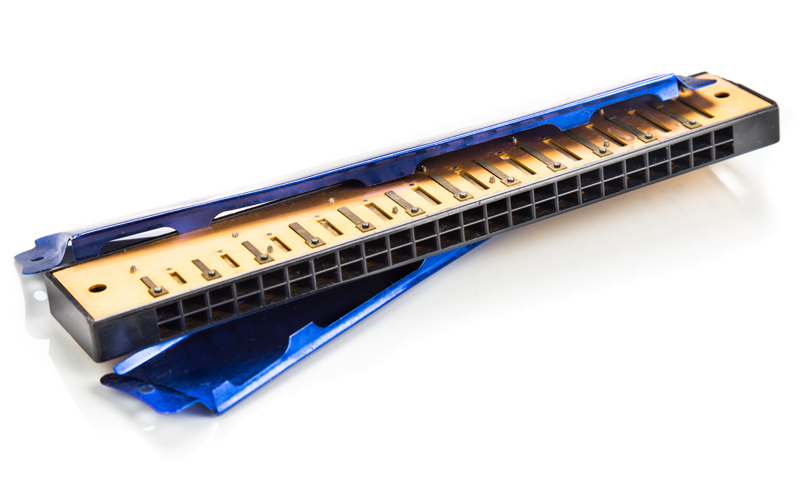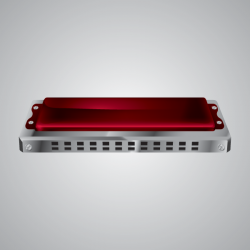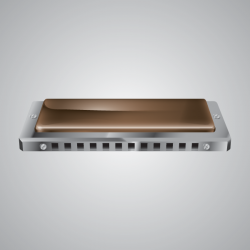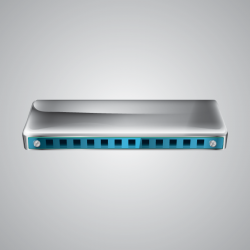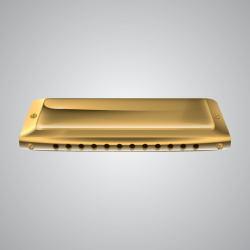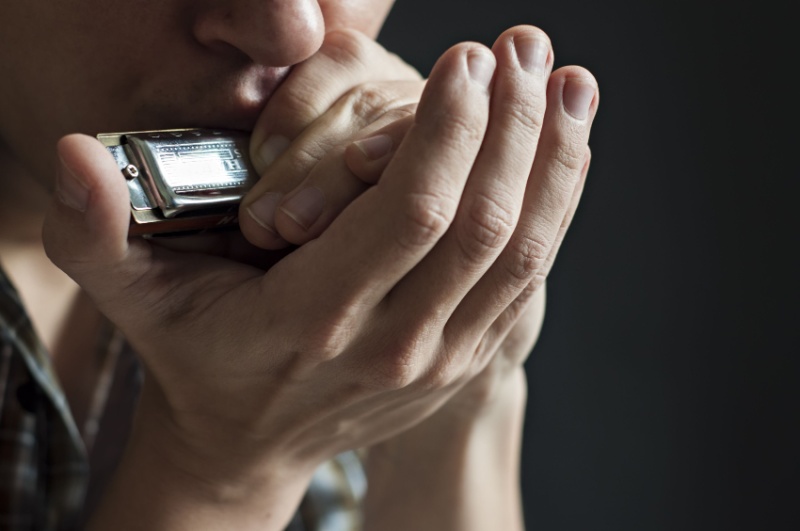The harmonica, often celebrated for its whimsical charm and melodious sound, boasts a deep and storied history that spans several centuries. Remarkably compact, this musical instrument fits easily into the palm of a hand or a pocket, making it a favorite among musicians for its portability and versatility. When played, the harmonica emits a rich array of sounds, achieved by the musician blowing into and drawing air out of its reeds, skillfully manipulating breath to create music.
This adaptability and the distinctive musical expression offered by the harmonica have cemented its place as a beloved instrument in the musical landscapes of both casual and professional settings. Whether echoing through a lively jam session or adding a soulful note to a solo performance, the harmonica continues to be a versatile and endearing presence in the world of music
HISTORY
The harmonica’s origins can be traced back around 1,000 years to ancient Asia, where early forms of this mouth organ were first developed. However, the modern harmonica as we know it today began its evolution in Germany in the early 19th century. Christian Bauschmann, a German musician and inventive mind, played a pivotal role in this development when he designed a new instrument in 1822, which he named the “aura.” This innovative design featured 15 reeds and was originally intended as a pitch pipe to assist in tuning and playing alongside other musical instruments.
Christian Bauschmann, a German musician and inventive mind, played a pivotal role in this development when he designed a new instrument in 1822, which he named the “aura.” This innovative design featured 15 reeds and was originally intended as a pitch pipe to assist in tuning and playing alongside other musical instruments.
The potential of the aura did not go unnoticed. Another enterprising German saw the commercial possibilities of Bauschmann’s design and started producing replicas to sell at affordable prices. This sparked interest among other manufacturers, leading to the mass production of the harmonica. The instrument quickly became popular for personal entertainment as well as for adding musical depth to theater performances.
PARTS
A harmonica is meticulously crafted from a variety of materials that contribute to its unique sound and playability. At the heart of this instrument is the “comb,” the outer case that can be made from plastic, wood, or metal. The comb not only provides structural support but also plays a role in the tonal quality of the harmonica.
Nested within this case are the reeds, the vital components that vibrate to produce sound when the musician blows or draws air through the harmonica’s 10 holes located along the edge. These reeds are typically fashioned from materials such as brass, steel, aluminum, or plastic, each contributing distinct characteristics to the sound. For example, brass reeds often deliver a warmer tone, while steel reeds are known for their brightness and resilience.
Surrounding the reeds is the cover plate, generally made from metal or plastic. This element is not just functional but also aesthetic, influencing the overall tone and sound of the harmonica. The choice of material for the cover plate affects the projection and timbre of the instrument, with metal plates typically producing a sharper sound compared to the softer tones from plastic plates.
Finally, the mouthpiece of the harmonica is designed to enhance playability. It facilitates the comfortable flow of air into and out of the reeds, enabling musicians to perform with ease and precision. This arrangement of components—comb, reeds, cover plate, and mouthpiece—works in concert to create the harmonica’s distinctive, melodious sound, making it a beloved choice among musicians of all genres.
TYPE
The diatonic blues harp harmonica stands out as one of the most popular and widely used types of mouth organs. The term “diatonic” refers to the instrument’s ability to play on a standard scale with specific keys, such as the key of C. This type of harmonica features ten holes, each producing a different note arranged in a particular pattern that covers a single key without any sharps or flats, making it ideal for blues, rock, country, and folk music.
Beginners particularly favor diatonic harmonicas due to their straightforward layout and ease of play. Unlike the chromatic harmonica, which includes a slide button to access additional notes and allows for playing in multiple keys, the diatonic harmonica’s simpler design focuses on a single key. This makes it less daunting for newcomers who are learning to navigate the basic techniques of harmonica play, such as bending notes and creating vibrato, essential skills for expressive music performance.
The construction of diatonic harmonicas, typically featuring reeds made of metal alloys like brass or bronze, is geared towards producing a bright, penetrating sound that cuts through in ensemble settings. This sonic characteristic, coupled with its user-friendly setup, makes the diatonic blues harp harmonica a perennial favorite among both aspiring musicians and seasoned performers.
Chromatic harmonicas are distinguished by their ability to play every note on the chromatic scale, including both natural and sharp or flat notes. This capability is a significant advantage for musicians, as it allows them to perform music in various keys without changing instruments. Such versatility is particularly useful in genres like jazz and classical music, where modulations and more complex scales are common.
The defining feature of a chromatic harmonica is its slide mechanism. This slide, when activated by the player, shifts the position of the harmonica’s reeds, enabling access to the sharp and flat notes that are not available in diatonic harmonicas. This mechanism effectively doubles the number of notes available to the musician, opening up a broader musical palette for more sophisticated compositions and performances.
Constructed typically with a more complex array of reeds and often housed in a durable metal body, chromatic harmonicas are designed for precise control and extended musical range. The slide’s addition makes the chromatic harmonica a bit more challenging to master compared to the diatonic harmonica, but it rewards skilled players with its rich tonal possibilities and adaptability across different musical styles.
TECHNIQUES
Playing the diatonic harmonica involves holding it between the thumb and index finger and curving the remaining fingers around the case to create a little space for sound resonation. Place the other hand over the harmonica to make a tight seal with both hands. The musician places the mouth on the mouthpiece over specific holes to play desired notes. It’s possible to play one note at a time or more than one note to create chords. Some chords require use of the tongue to block certain holes.
With practice, the harmonica player will learn different techniques such as the pucker, the lip-block, and the U-block to play notes and chords. Some musicians learn a special technique called “vocaling.” To perform this type of playing, you would actually speak words or sing into the mouthpiece. For example, saying the sounds “too wee” into the mouthpiece creates a distinctive train whistle sound with the harmonica.
FUN FACTS

Although harmonicas appear simple in design, these mouth harps are actually a very difficult and complicated instrument to learn and master. A number of famous musicians have incorporated the harmonica into theater stage performances and recorded music.
Credence Clearwater Revival included harmonica music in their hit song “Down on the Corner.” Ella Fitzgerald typically included harmonica music in her live performances. Stevie Wonder even played the harmonica in some of his recorded songs.
LINKS
- Harmonica Tabs
- Bending Notes on the Harmonica (PDF)
- Acoustical and Physical Dynamics of the Diatonic Harmonica (PDF)
- The Harmonica
- ‘Pocket Full Of Soul’ Explores the Harmonica’s History
- 100 Years of the Harmonica
- The Harmonica Story (video)
- Harmonicas Are Hooty, Wheezy, Twangy, and Tooty
- Pitch Control in Harmonica Playing (PDF)
- Harmonica Tunings for Playing Solo (PDF)
- Student Guide for Solo-Tuned Harmonica (PDF)
- The Renaissance of the Harmonica (audio)


